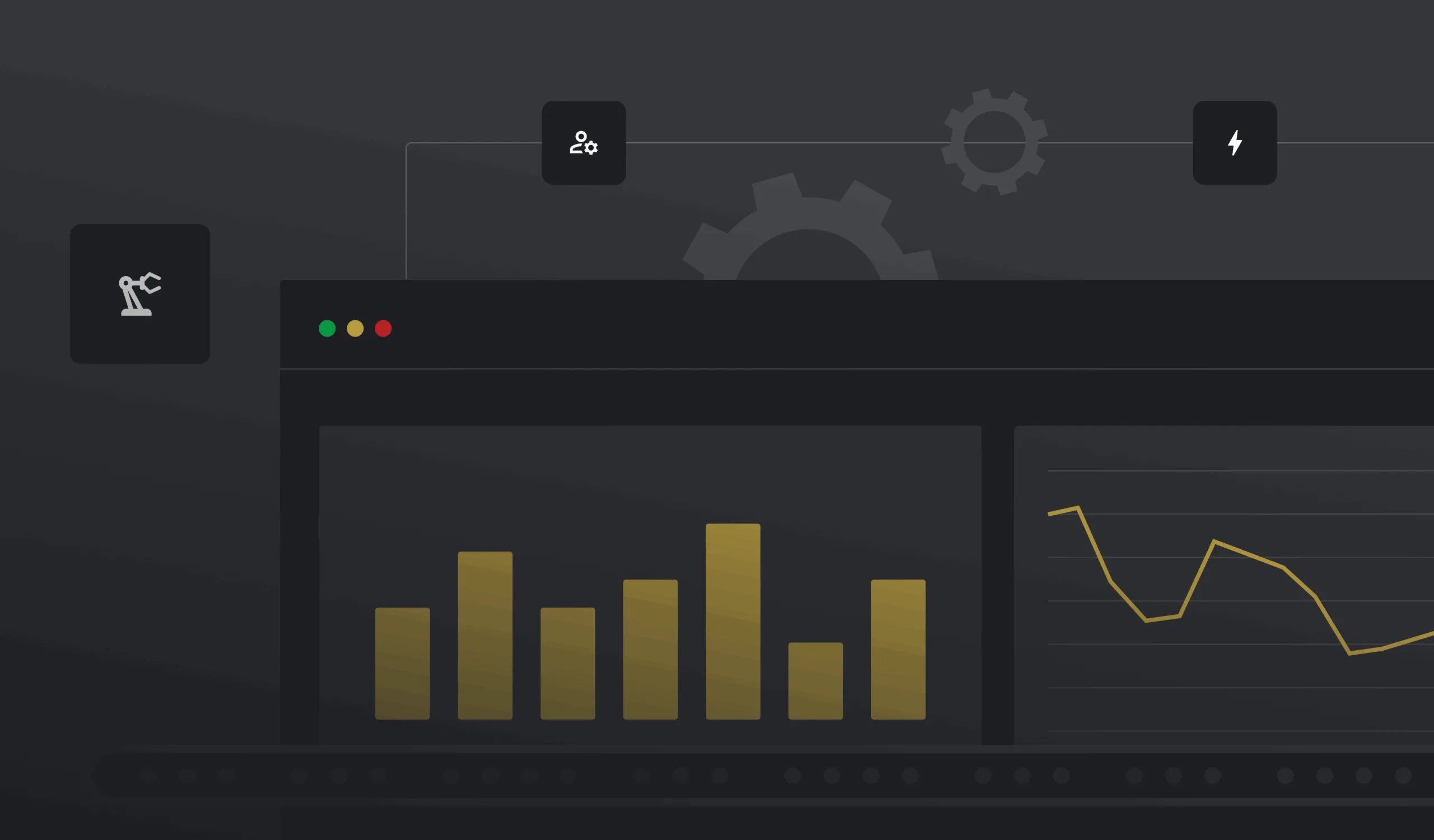Manufacturing digital transformation isn’t just about adopting new technology – it’s about rethinking how your business operates, serves customers, and innovates in a fast-changing world. The manufacturing industry as a whole is being transformed by digital initiatives that drive efficiency, resilience, and sustainability. From automated production lines to AI-driven maintenance, the modern factory is becoming a smart, data-powered ecosystem.
Yet, many manufacturers are still struggling with outdated systems, disconnected teams, and siloed data. Businesses in the manufacturing industry face significant challenges when implementing digital transformation, such as integrating new technologies and managing change. According to a Deloitte survey, only 24% of manufacturers have a clear digital roadmap, even though 70% increased investments post-pandemic. That disconnect creates risk – and opportunity.
In this guide, we’ll walk through a future-ready strategy that helps businesses in the manufacturing industry address common challenges and opportunities, including how to:
- Modernize operations
- Improve customer experience
- Scale e-commerce
- Lay the foundation for AI and automation
Whether you’re just starting your journey or looking to accelerate progress, this article gives you the roadmap you need.
What’s Driving Manufacturing Digital Transformation?
Manufacturing companies are facing pressure from multiple directions — shifting customer expectations, labor constraints, rising operational costs, and supply chain uncertainty. For a manufacturing business, digital transformation is essential to improve efficiency, streamline operations, and remain competitive in a rapidly evolving market. To stay competitive and maintain operational efficiency, manufacturers are turning to digital technologies not just to automate tasks, but to gain better visibility, make faster decisions, and deliver more consistent customer experiences.
The following factors are prompting manufacturers to modernize how they operate, manage data, and serve customers.
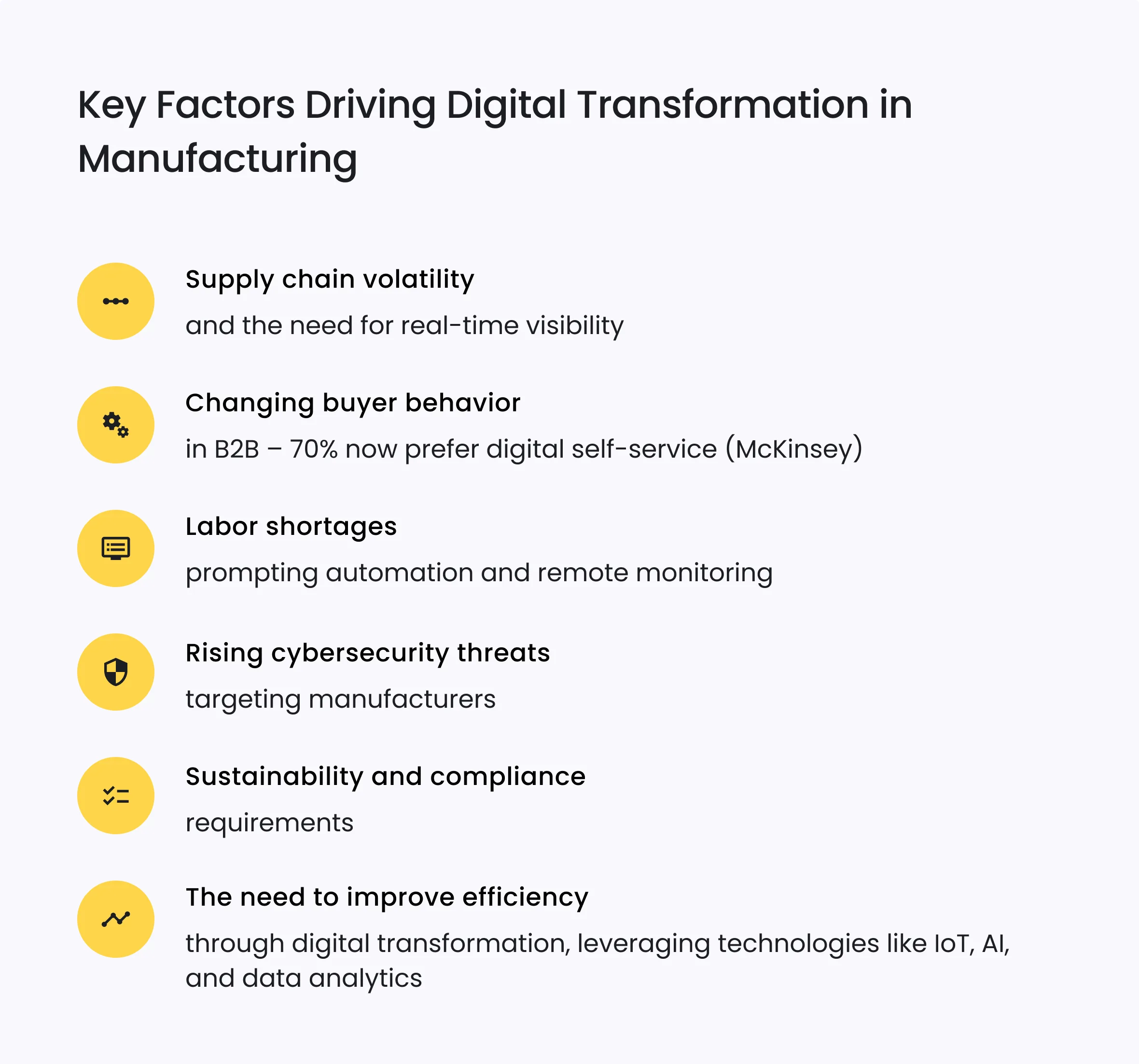
The 7 Pillars of a Future-Proof Manufacturing Digital Transformation Strategy
To thrive in today’s industrial economy, manufacturers must do more than adopt technology — they must build a resilient digital foundation. Choosing the right technology is crucial, as it ensures that digital transformation efforts are supported by solutions that align with business needs and enable long-term growth. That means combining the right tools, processes, and cultural shifts to ensure that digital investments drive real business value now and in the future.
Here are the seven strategic pillars every manufacturer should prioritize.
1️⃣ Modular, API-First Technology Stack
A modular, API-first technology stack is the backbone of successful digital transformation in manufacturing. By designing systems that are flexible and easily integrated, manufacturing companies can rapidly adopt new digital technologies—such as artificial intelligence, machine learning, and IoT—without overhauling their entire infrastructure. This approach enables manufacturers to create a digital thread that seamlessly connects every stage of the manufacturing process, from initial design to final production.
With real-time data collection and analysis at every step, manufacturers can make smarter, faster decisions that drive business growth and improve overall efficiency. For example, integrating machine learning algorithms into production lines allows for predictive quality control, while IoT sensors provide instant feedback on equipment performance. This interconnectedness not only streamlines manufacturing processes but also empowers companies to respond quickly to market changes and customer demands.
Ultimately, a modular, API-first technology stack enables manufacturers to future-proof their operations, ensuring that their digital transformation in manufacturing delivers lasting value and positions them for continued success in an increasingly digital world.
2️⃣ Unified Data Infrastructure
Siloed systems limit visibility and slow decision-making. A unified data infrastructure ensures that insights from operations, sales, quality, and supply chain can be accessed in real time.
- Enables predictive analytics, quality tracking, and supply chain visibility
- Supports AI and machine learning models by ensuring high data quality
- Reduces errors and manual data reconciliation across departments
📊 McKinsey estimates that data-driven decision-making in manufacturing can improve productivity by up to 20%.
3️⃣ Customer-Centric User Experience
B2B buyers expect digital convenience. Outdated portals and friction-heavy processes lead to lost sales and reduced customer satisfaction.
- Build responsive portals with real-time pricing, inventory, and configuration tools by implementing digital applications that enhance user experience and support in-app guidance
- Use behavioral data to personalize the buying experience
- Provide post-sale support through chat, dashboards, and self-service tools
📊 Forrester reports that 67% of B2B buyers prefer self-service over speaking to a sales rep when purchasing repeat products.
4️⃣ Cybersecurity by Design
Cyberattacks on manufacturing organizations have surged — targeting both IT and operational technology (OT) systems. Secure digital systems must be built from the ground up.
- Protects intellectual property, production data, and connected equipment
- Implements identity management, endpoint protection, and continuous monitoring
- Supports compliance with standards like NIST, ISO/IEC 27001, and CMMC
📊 IBM's 2024 report lists manufacturing as the top-targeted industry for ransomware for the second consecutive year.
5️⃣ Scalable E-Commerce & Customer Portals
Digital sales channels are no longer optional in B2B. Buyers expect Amazon-like speed, transparency, and control — even for complex products.
- Enable real-time quote generation, bulk ordering, and payment tracking
- Integrate PIM, ERP, and CRM for accurate, personalized experiences
- Automate contract pricing, inventory checks, and reordering workflows
📊 Gartner found that companies with strong digital commerce platforms grow 2.5x faster than those relying solely on traditional sales.
6️⃣ AI & Automation Readiness
AI and automation are no longer futuristic — they’re driving measurable impact in quality control, maintenance, and planning.
- Use AI technology and machine learning to predict equipment failures, optimize production processes, and improve product quality through better maintenance schedules
- Automate quality checks using AI technology, computer vision, and analytics to enhance product quality with advanced analytics and automation
- Support demand forecasting and production planning with historical and external data
📊 According to Deloitte, manufacturers using AI in predictive maintenance reduce downtime by 15–30% and increase asset life by 20%.
7️⃣ Digital Culture & Workforce Enablement
Technology alone won’t transform a business. Success depends on your team’s ability to adapt, learn, and lead change.
- Provide continuous learning opportunities and role-based digital training, including programs specifically designed for engineers to address evolving skills requirements
- Recognize and support internal “digital champions”
- Foster a culture of experimentation, transparency, and feedback
📊 A World Economic Forum study shows that manufacturers with strong digital talent strategies are 3x more likely to succeed in transformation initiatives.
Collaboration and Partnerships: Accelerating Transformation
Collaboration and partnerships are key drivers of digital transformation in manufacturing, enabling companies to access cutting-edge digital capabilities and innovative solutions that might otherwise be out of reach. By working closely with technology vendors, startups, and other industry partners, manufacturers can accelerate the adoption of new technologies and stay ahead in a competitive landscape.
Strategic partnerships with technology vendors provide manufacturers with access to the latest digital solutions, helping to streamline manufacturing processes, reduce costs, and deliver superior customer experiences. Collaborating with startups can inject fresh ideas and agile approaches into established operations, fostering innovation and enabling manufacturers to quickly adapt to market changes.
These collaborative efforts not only enhance a manufacturer’s digital capabilities but also support business growth by opening up new opportunities and markets. In a rapidly evolving industry, manufacturers that prioritize collaboration and partnerships are better positioned to stay ahead, reduce costs, and deliver exceptional value to their customers.
A Practical 5-Step Roadmap to Manufacturing Digital Transformation
Embarking on a digital transformation journey can feel overwhelming — especially in complex manufacturing environments where operations, systems, and teams are deeply intertwined. Digital transformation is about creating new opportunities, products, and processes that drive innovation and competitive advantage. However, successful transformations don’t happen all at once. They are the result of clear planning, cross-functional alignment, and a phased approach that delivers value early and often.
This roadmap outlines five essential steps that help manufacturers reduce risk, build internal momentum, and ensure their digital strategy drives measurable outcomes. Whether you’re starting from scratch or accelerating an existing initiative, these steps provide a practical foundation to guide your organization through change.
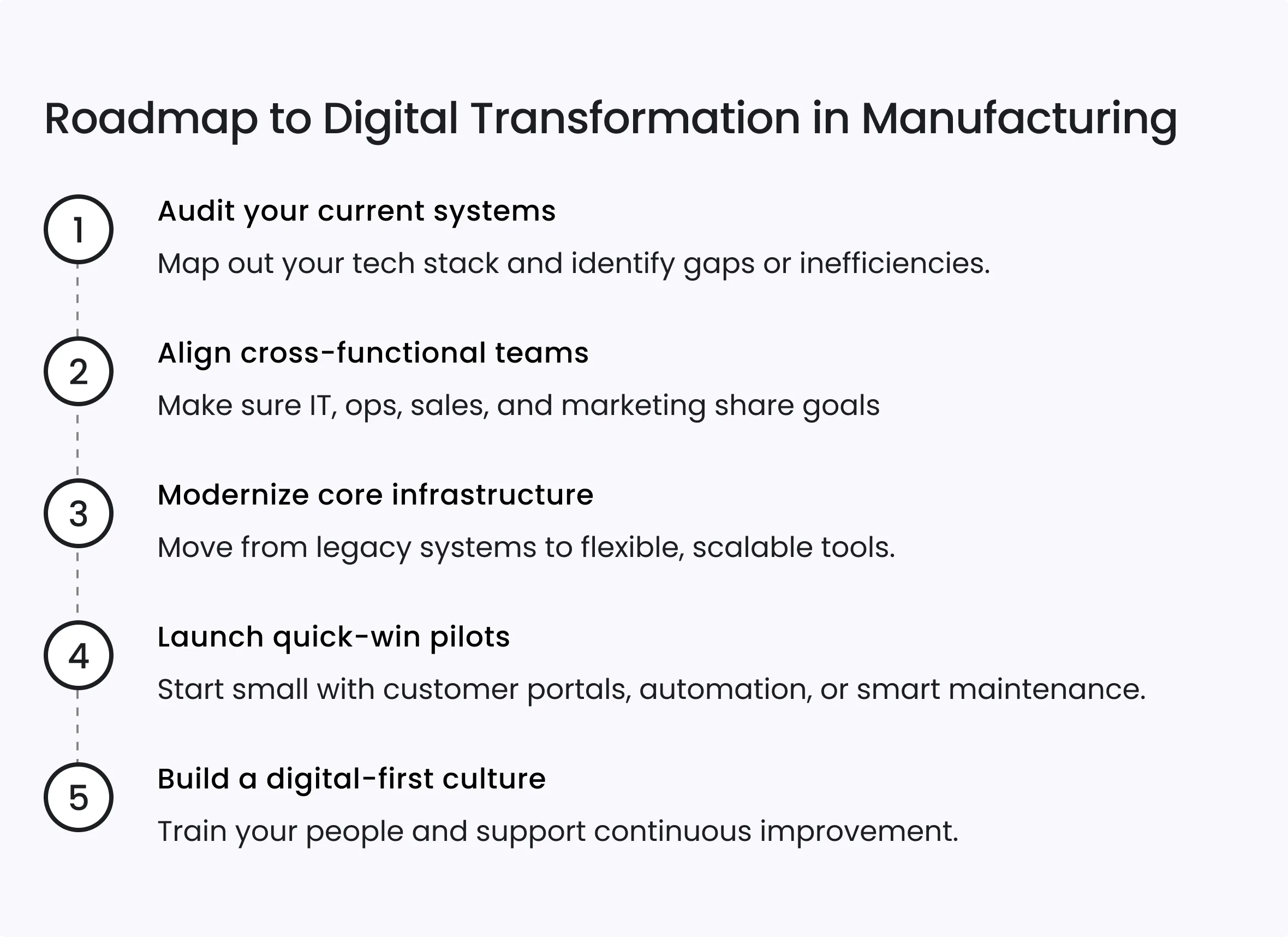
Real-World Results of Digital Transformation in Manufacturing
Digital transformation in manufacturing is not just theory — it’s producing tangible business results across the globe. From speeding up time-to-market to reducing operational costs and improving customer satisfaction, leading manufacturers are already realizing the benefits of investing in modern digital systems.
The following real-world examples highlight how organizations are using digital tools and strategies to solve specific business challenges, streamline processes, and achieve measurable gains. These case studies demonstrate that with the right approach, transformation delivers fast, scalable, and lasting impact.
SKF Bearings
Challenge
SKF, a global supplier of bearings and related components, was facing inefficiencies in its distributor experience. The quoting process was manual, slow, and frustrating for partners — often taking up to two days to return pricing and availability.
Solution
SKF implemented a digital self-service quote builder integrated with their backend systems. This tool enabled distributors to generate real-time quotes instantly, reducing the need for manual intervention from sales teams.
Result
The quote generation process dropped from 2 days to just 15 minutes, significantly improving distributor satisfaction, speeding up order cycles, and freeing up internal resources.

Danfoss
Challenge
Danfoss, a global engineering leader, struggled with lengthy deployment times for regional websites and marketing campaigns. Their traditional CMS and legacy workflows couldn’t keep pace with business needs, slowing time-to-market and limiting flexibility across global teams.
Solution
The company migrated to a composable digital experience platform (DXP) with a headless CMS architecture. This modern, API-first setup allowed regional teams to localize and launch content independently, while maintaining brand consistency and performance at scale.
Result
Danfoss reduced campaign rollout time by 60%, enabling faster market responsiveness, more localized customer engagement, and improved digital operations across global teams.
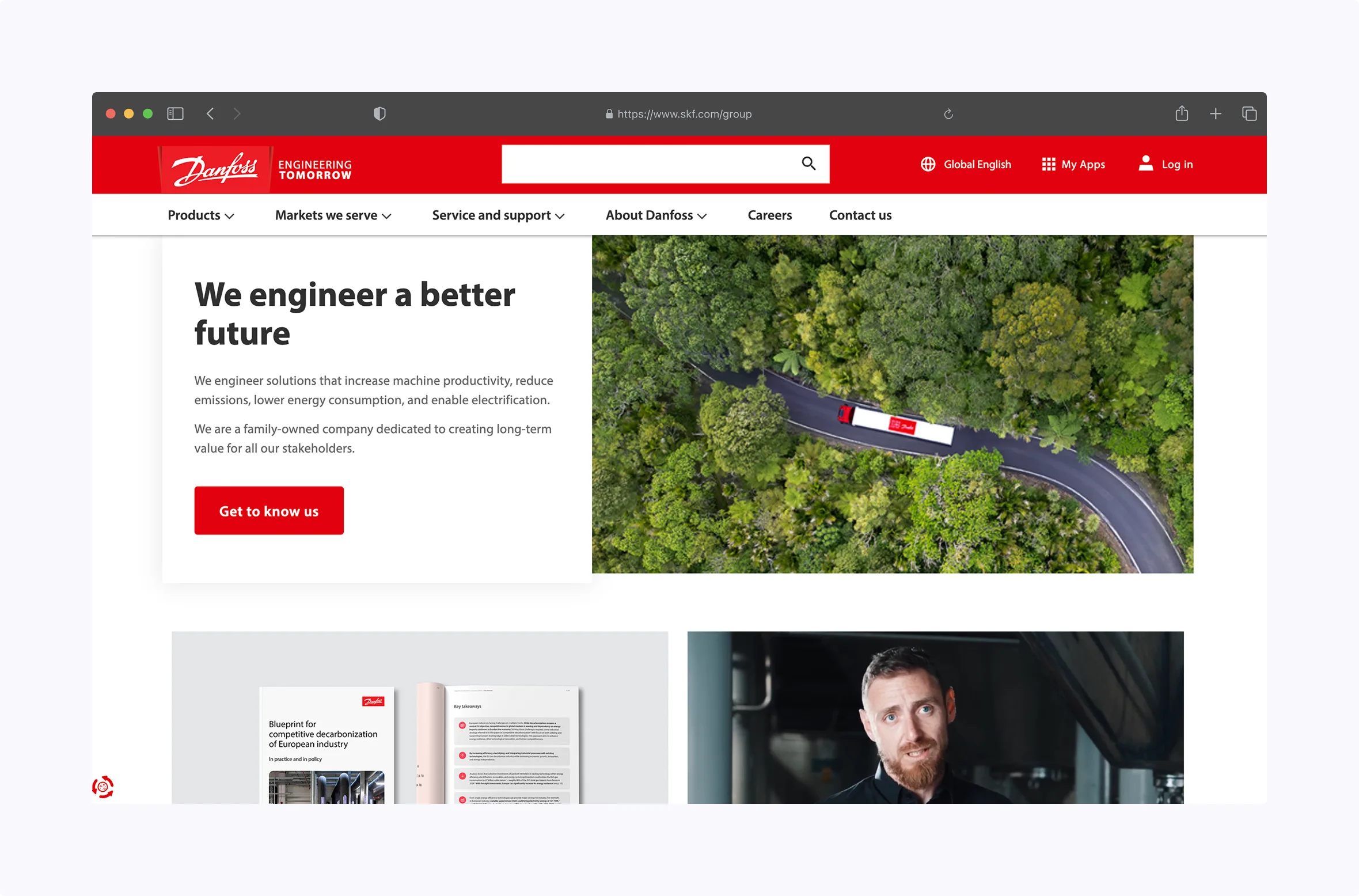
BMW Regensburg Plant
Challenge
BMW’s Regensburg automotive plant was grappling with unplanned downtime and high maintenance costs as manual systems couldn’t proactively flag equipment issues.
Solution
The plant implemented an AI-based predictive maintenance solution, leveraging sensor data and machine learning to monitor key production assets and predict failures before they happen. Preventive maintenance strategies were also integrated to complement predictive maintenance, helping further reduce equipment failures by addressing potential issues before they occur.
Result
Maintenance costs dropped significantly, and production efficiency increased. Though specific figures weren’t disclosed, BMW’s internal reports highlight “significant improvements in production efficiency and operational excellence” due to early detection of potential failures.
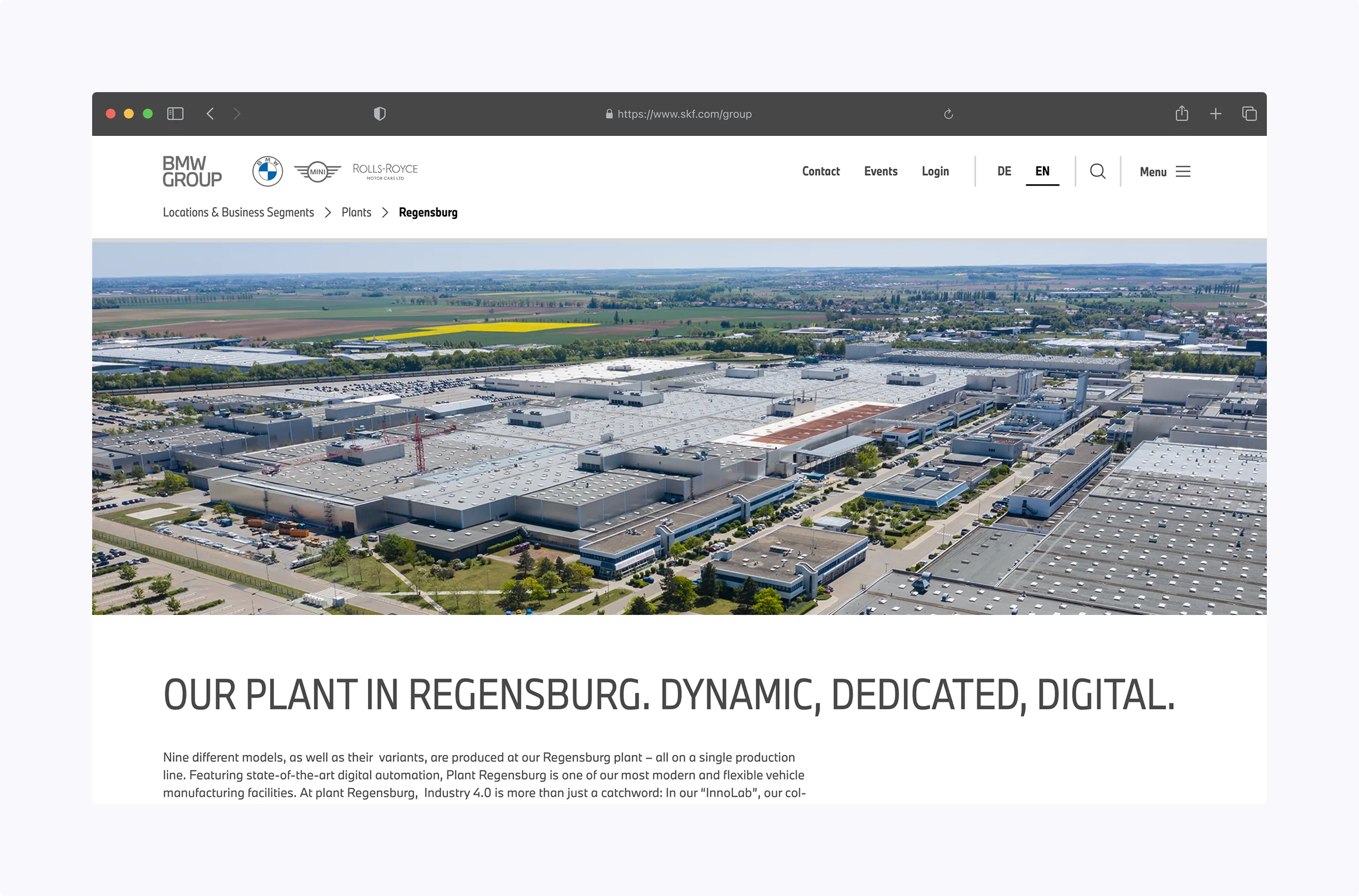
Related Terms and Concepts in Manufacturing Digital Transformation
To help you expand your understanding, here are some closely related industry terms:
- Industry 4.0: The fourth industrial revolution — driven by smart technologies and IoT
- Digital twin: A virtual replica of physical systems used for monitoring and simulation
- MES (Manufacturing Execution System): Real-time production control software
- PLM (Product Lifecycle Management): Tools for managing product data and workflows
- Smart factory: Highly automated, digitally connected manufacturing environments
Industrial internet: The network of connected industrial devices and systems that enable real-time data exchange and process optimization
Measuring Success in Digital Manufacturing
Digital transformation is only effective if it delivers measurable outcomes. To justify investments, align cross-functional teams, and ensure continuous improvement, manufacturers must track the right performance indicators. These KPIs should reflect both operational impact and user adoption — providing a clear picture of how well your digital initiatives are improving productivity, reducing costs, reducing rework, and enhancing customer experience. Reducing rework is a key indicator of improved efficiency and quality in digital manufacturing. Below are five essential KPIs that successful manufacturers use to evaluate their progress and refine their strategy over time.
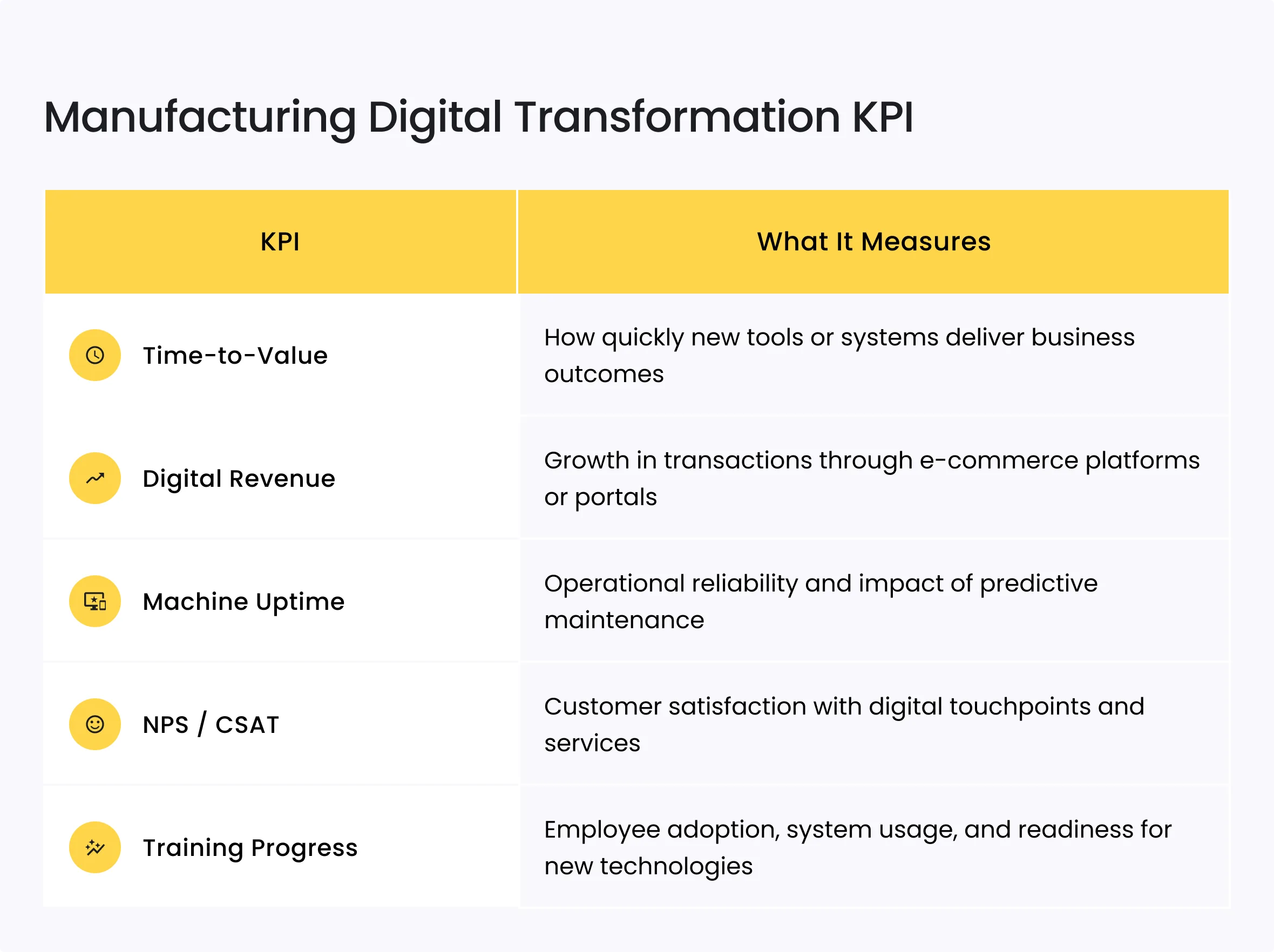
FAQ: Manufacturing Digital Transformation
What is manufacturing digital transformation?
Manufacturing digital transformation is the strategic integration of digital technologies — such as IoT, AI, cloud platforms, and automation — across the entire value chain. It affects everything from shop floor operations and supply chain visibility to customer experience and after-sales service. The goal is to improve agility, reduce costs, increase efficiency, and stay competitive in an increasingly data-driven economy.
🔎 It’s not about adopting a single tool — it’s about rethinking processes and enabling better decision-making through connected systems.
How long does a transformation take?
Timelines vary depending on company size, goals, and digital maturity. Most manufacturers start seeing meaningful results from early initiatives — like predictive maintenance or customer portal rollouts — within 6 to 12 months. Full enterprise-wide transformation can take 2–5 years, especially when it involves core system modernization (like ERP replacement or factory automation).
⏱ Best practice: Start with small, high-impact pilots and scale based on results. This reduces risk and builds internal buy-in.
What systems should we modernize first?
Begin with the systems that create the most friction or have the highest customer impact. These typically include:
- Customer-facing systems: B2B e-commerce platforms, distributor portals, digital product catalogs
- Core operational systems: ERP, MES (Manufacturing Execution Systems), SCM (Supply Chain Management)
- Data and analytics layers: Tools that unify data across departments to improve visibility and decision-making
🎯 Tip: Focus on quick wins that align with business goals — like reducing lead times, improving order accuracy, or enhancing visibility into inventory.
Can small or mid-sized manufacturers afford digital transformation?
Yes — and in many cases, they can’t afford not to. Thanks to the rise of cloud-based platforms, subscription pricing, and modular (composable) architectures, SMBs can implement digital tools incrementally without large upfront costs.
💡 Smaller manufacturers often benefit from being more agile, enabling them to test and adopt digital tools faster than larger enterprises.
📈 According to a PwC survey, 45% of small and medium manufacturers saw ROI from digital investments within the first year.
How Five Jars Helps Manufacturers Transform
At Five Jars, we partner with manufacturers to design and implement scalable, user-friendly, and secure digital solutions that drive measurable impact.
Our services include:
- Technology Consulting & Strategy – Audit your stack, design your digital roadmap, and choose the right tools
- Custom Development – Build scalable, API-ready web portals, e-commerce systems, and mobile solutions
- UX/UI Design – Create intuitive, accessible user experiences for internal teams and external customers
- System Integrations – Connect your ERP, CRM, PIM, and other core platforms for real-time data flow
- Ongoing Support – Stay secure, up-to-date, and continuously optimized
Whether you’re replacing outdated systems, launching a new platform, or connecting your tools into a cohesive ecosystem – we’re here to help.
The Time for Transformation Is Now
Manufacturing digital transformation is no longer a question of “if” — it’s a matter of how fast and how smart you move.
Start small. Stay aligned. Build for agility.
And remember: The best time to future-proof your systems was yesterday.
The next best time? Today.
Ready to future-proof your operations? Talk to us today
